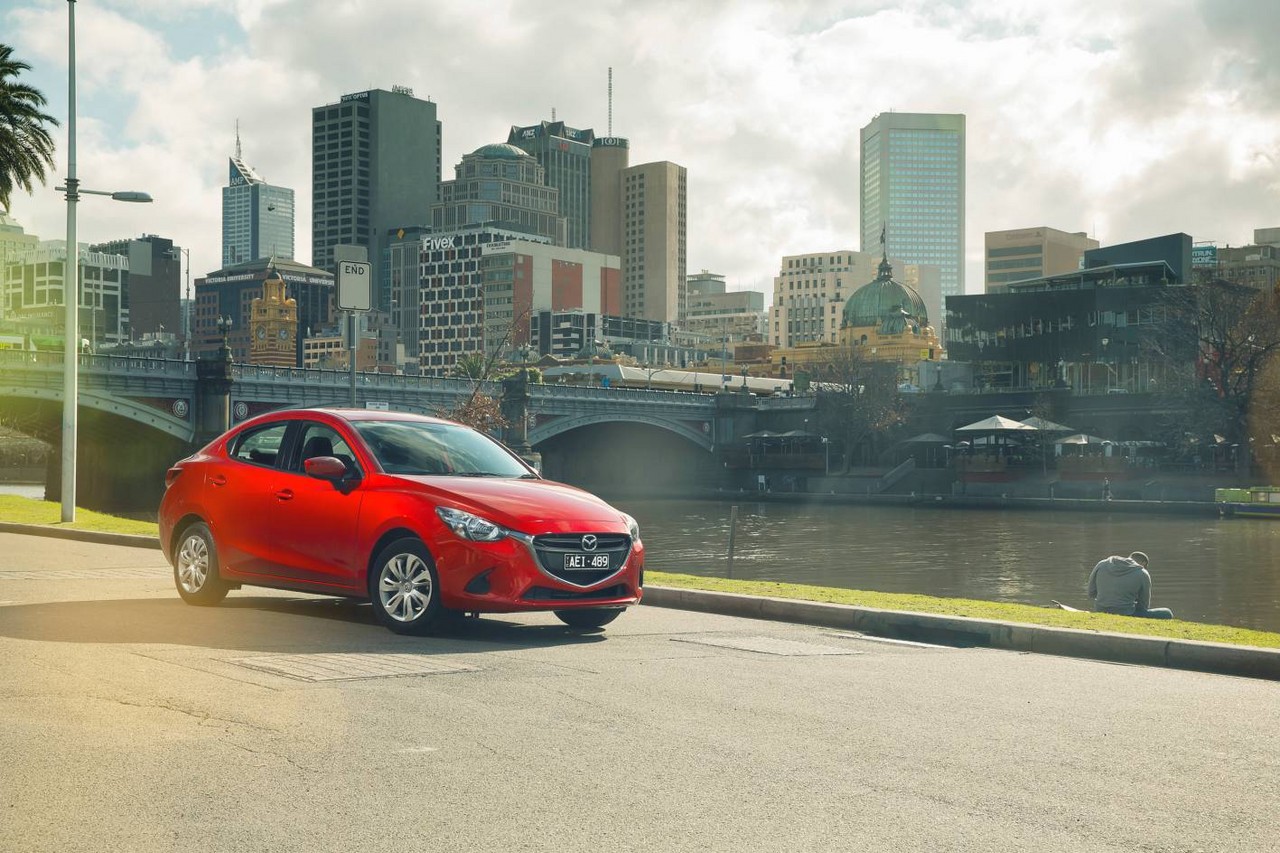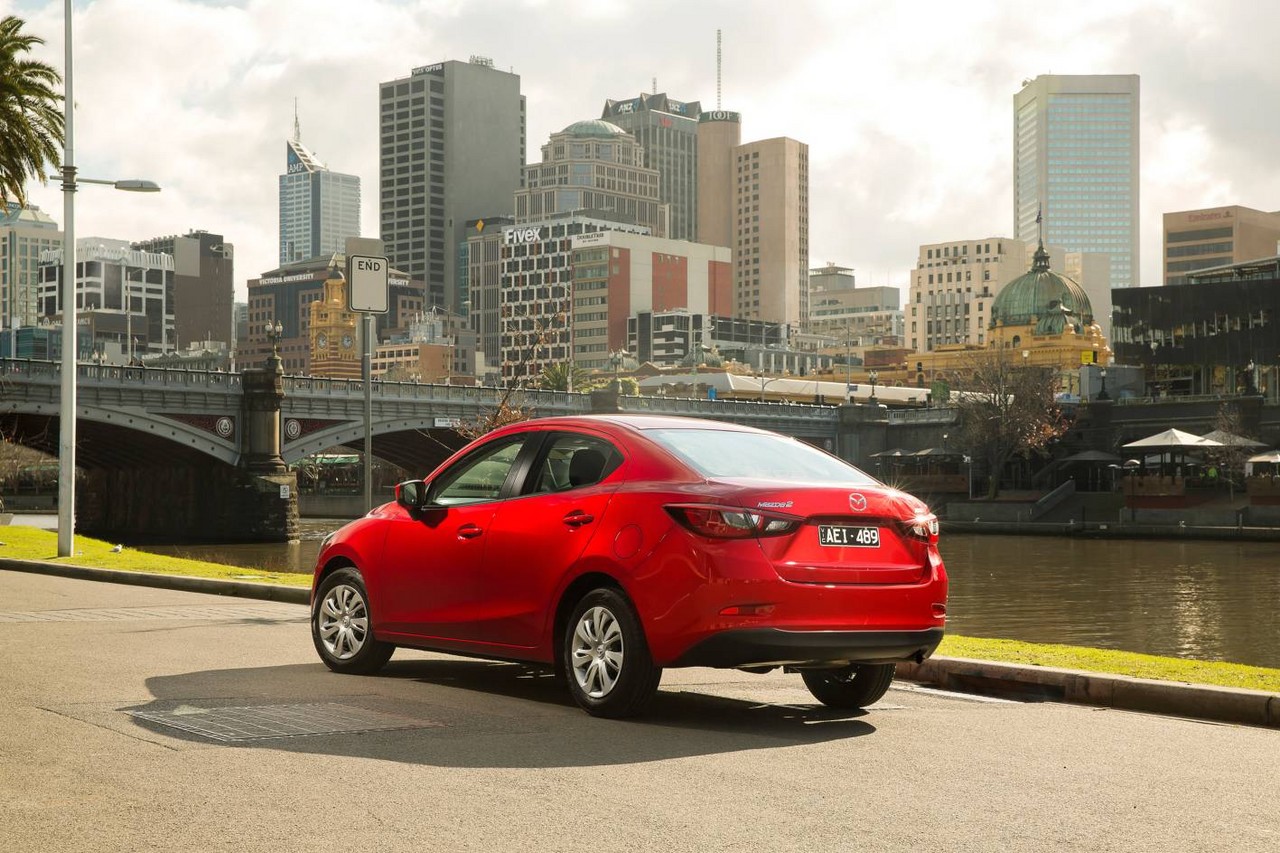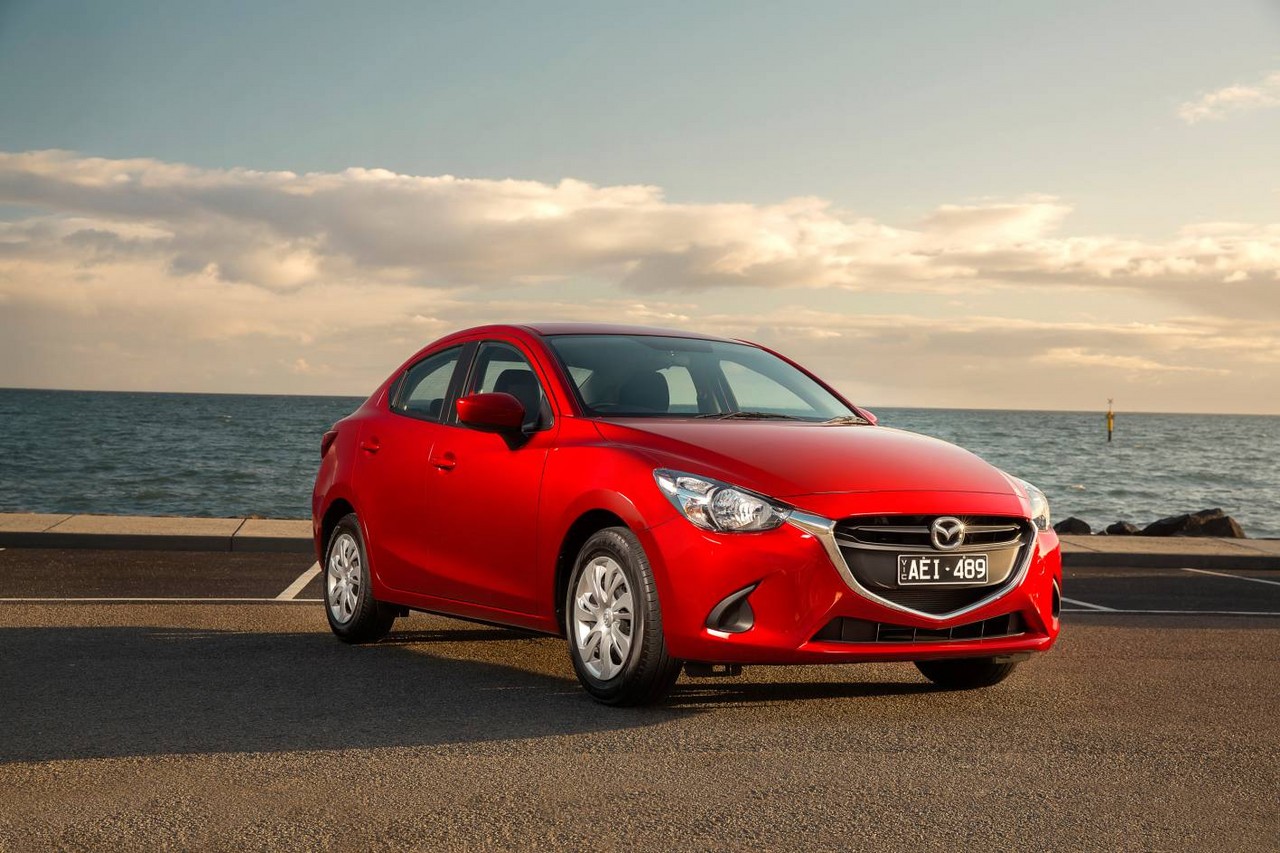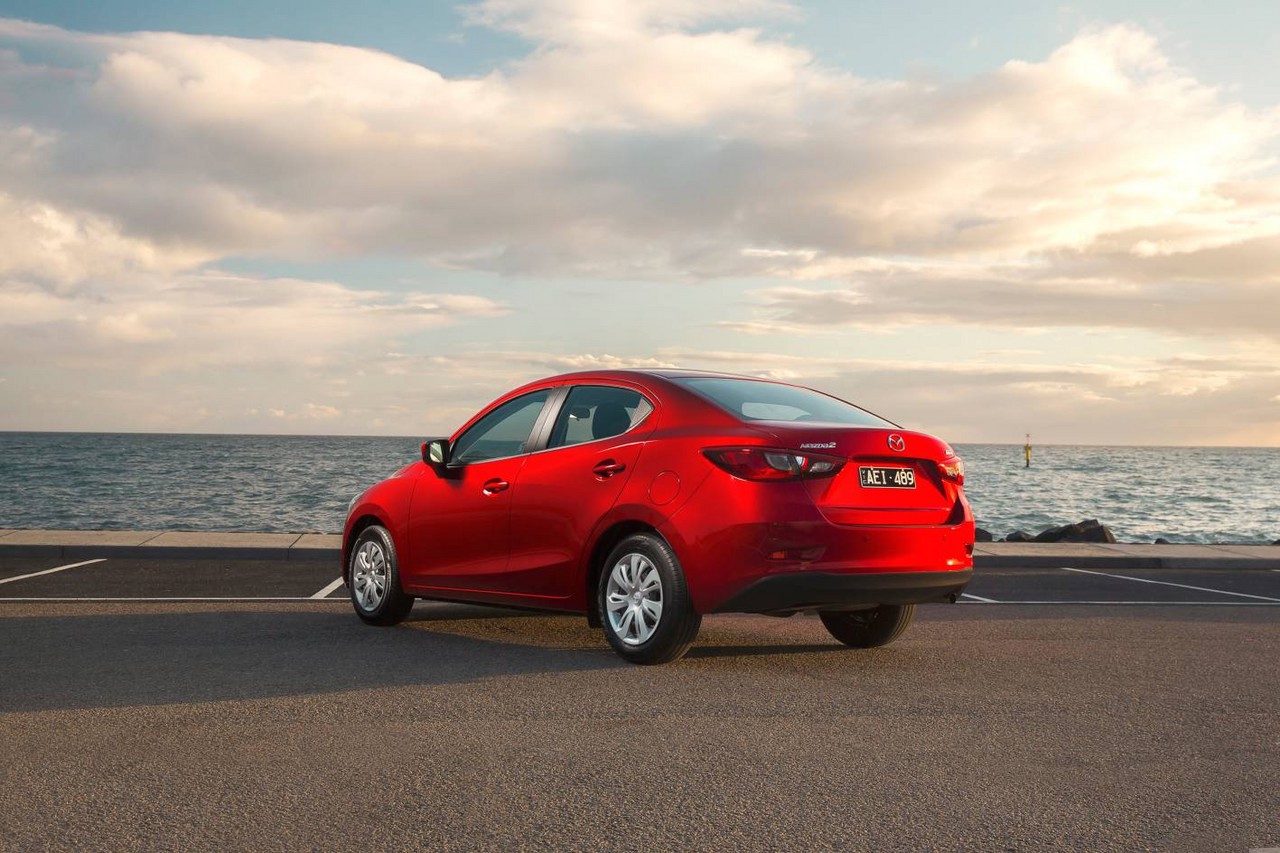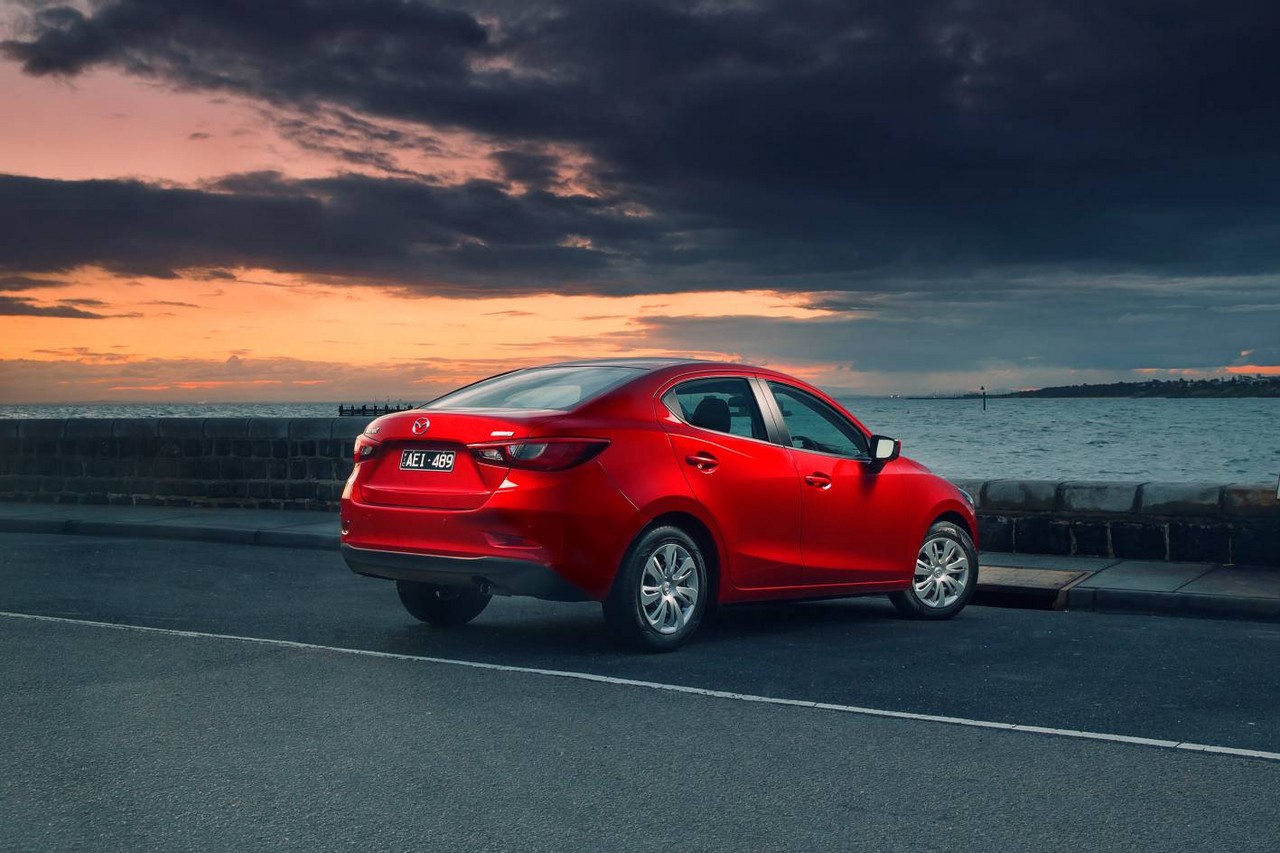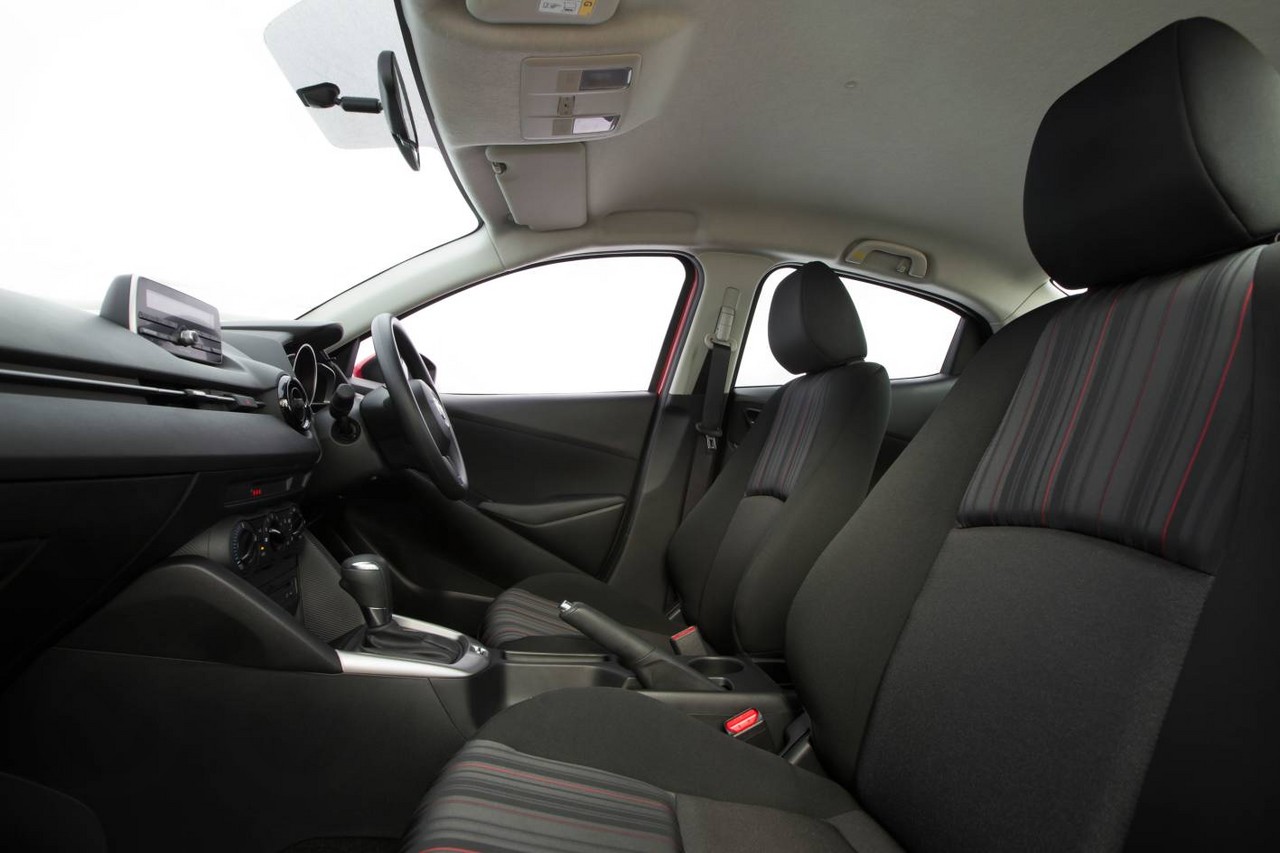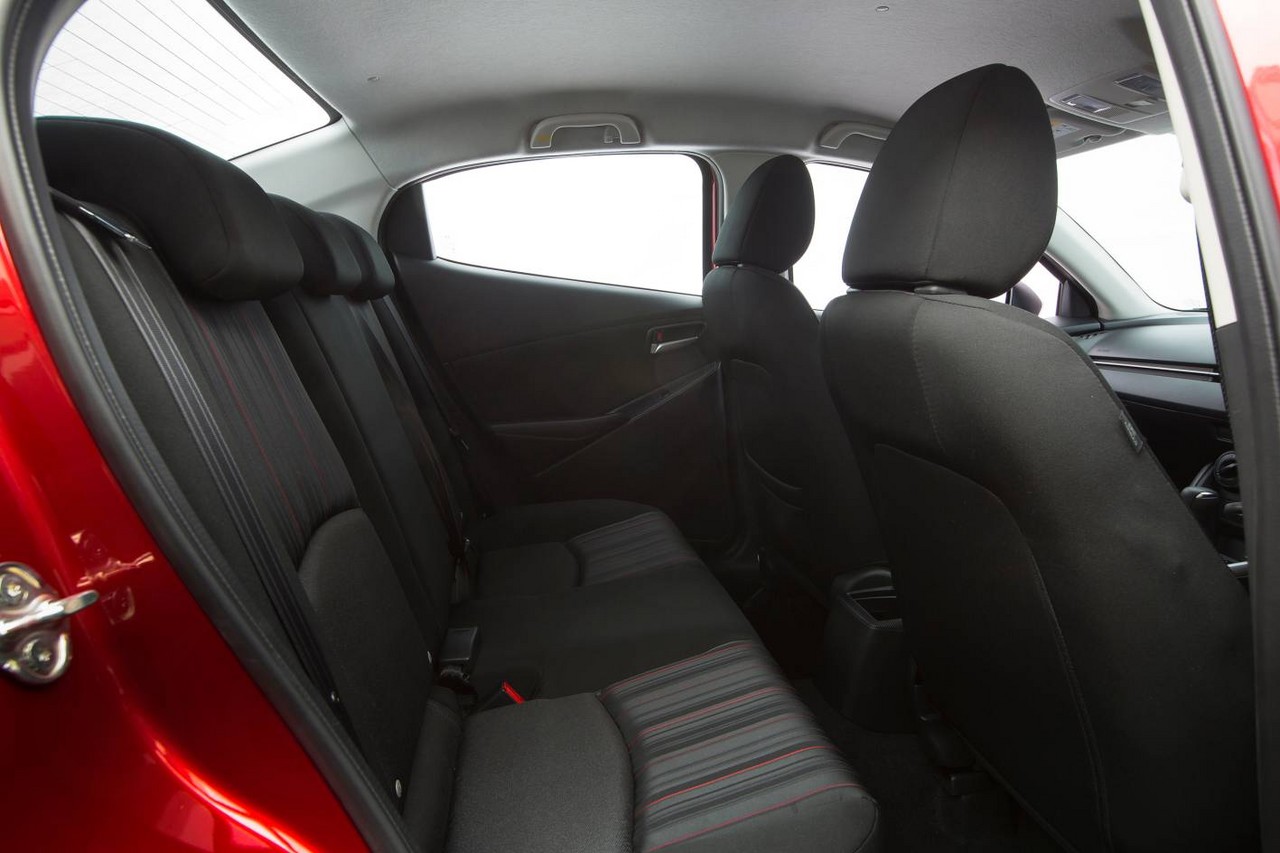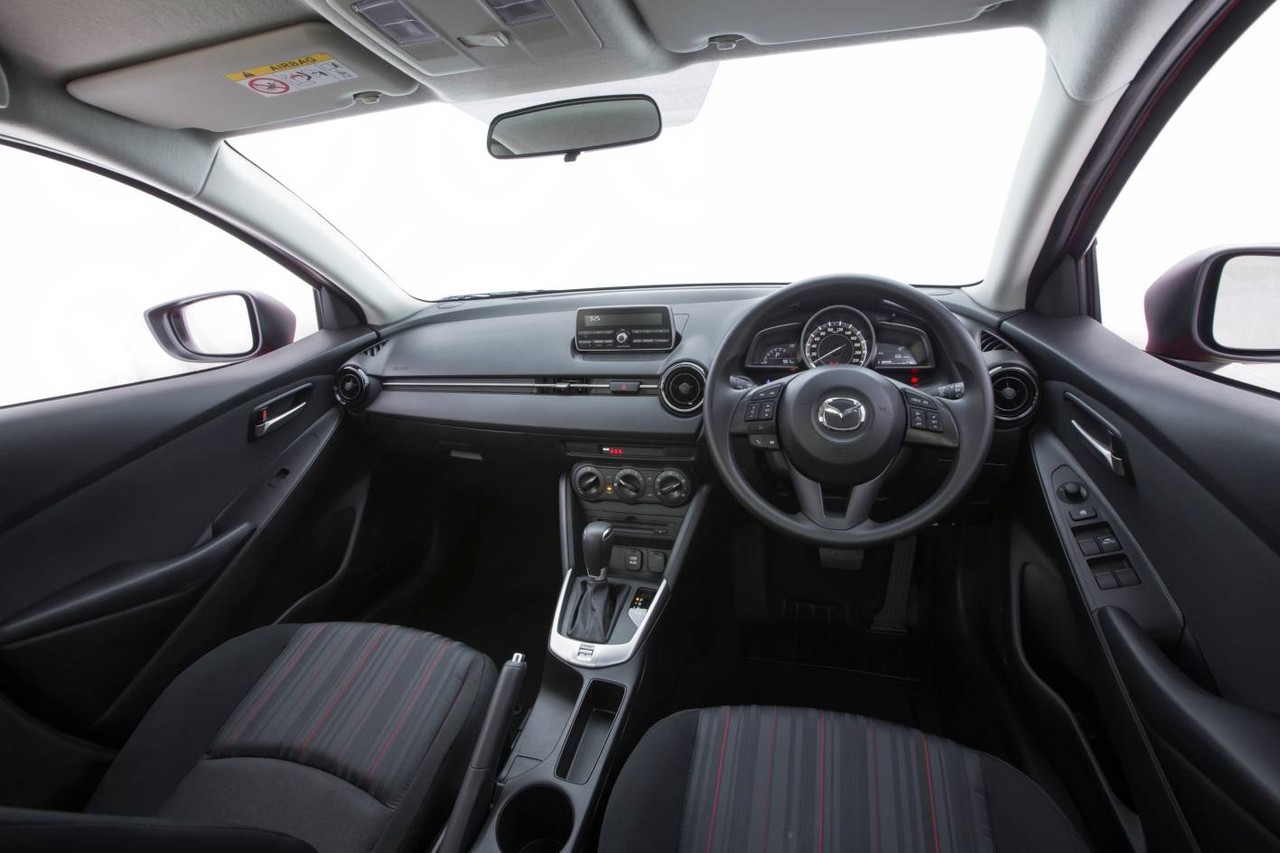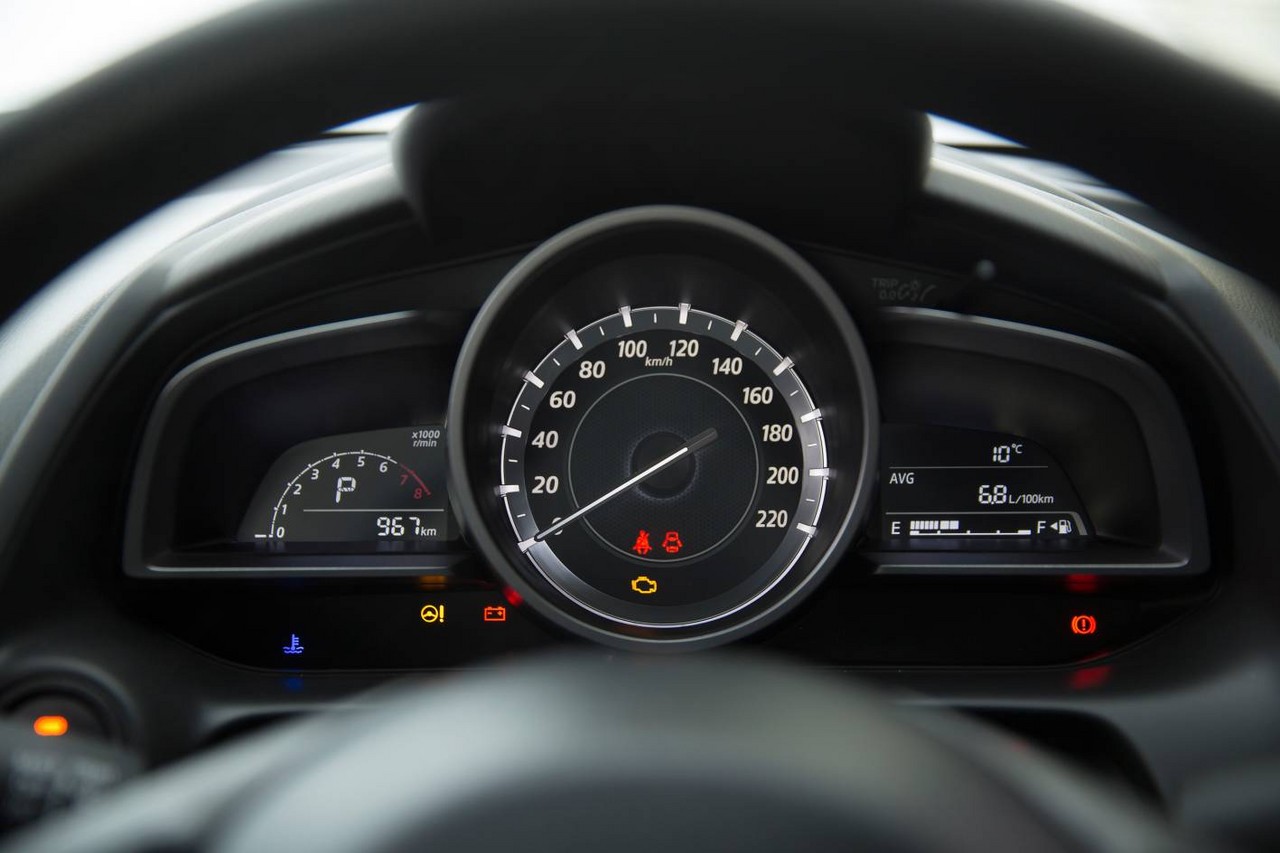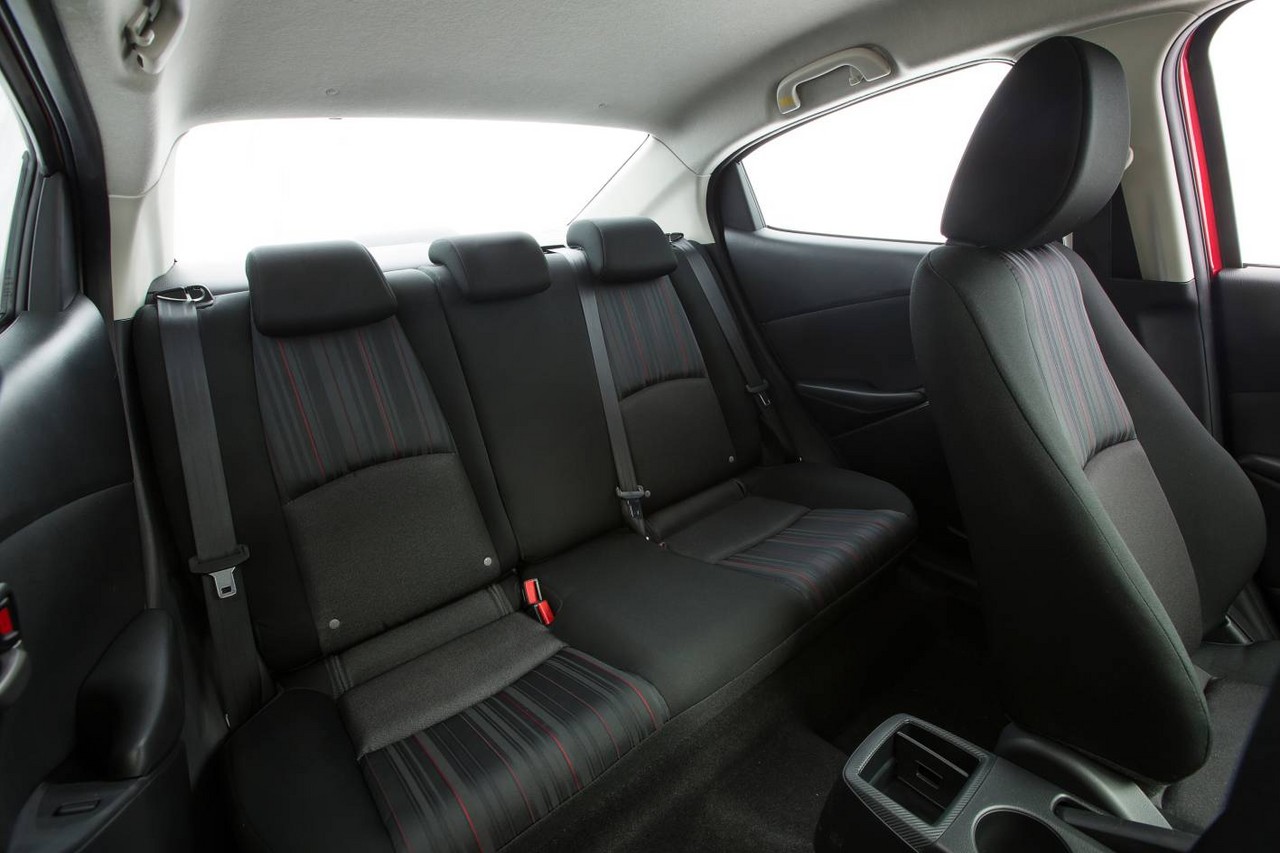
- Willing 1.5-litre petrol engines
- Impressive ride/handling balance
- Slick manual gearshifts
- Steering is well-weighted…
- … but lacks feel
- Limited rear seat leg and headroom
- Cabin lacks sound insulation
- Thick B-pillars restrict visibility
Review: Mazda DL.I Mazda2 sedan (2015-17)
Overview
Released in Australia in August 2015, the Mazda DL Mazda2 was as a light, front-wheel drive sedan. Manufactured in Thailand (for Australian-delivered vehicles), the Mazda DL Mazda2 was available with a 1.5-litre ‘SkyActiv-G’ four-cylinder petrol engine that was mated to either a six-speed manual or automatic transmission. While the DJ Mazda2 hatch was available in Neo, Maxx and Genki variants, the DL Mazda2 sedan was only available in Neo and Maxx variants.
SkyActiv-G engines and transmissions
The 1.5-litre SkyActiv-G four-cylinder petrol engines had aluminium blocks and cylinder heads, electronic direct petrol injection, double overhead camshafts, four valves per cylinder, and a maximum engine speed of 6800 rpm. For the DL Mazda2, the SkyActiv-G engine was offered in two forms:
- For the Mazda2 Neo, the standard output V-P5 engine had oil intake sequential valve timing (‘SVT’), a 4-1 exhaust system and compression ratio of 12.0:1; and,
- For the Mazda2 Maxx and Genki, the high output F-P5 engine had electric intake sequential valve timing, oil exhaust sequential valve timing, a 4-2-1- exhaust system, an electric oil pump, a compression ratio of 13.0:1 and an ‘i-stop’ function that enabled the engine to shut down when the vehicle was stationary in traffic.
The SkyActiv-G engine was mated to six-speed ‘Skyactiv-Drive’ automatic and ‘Skyactiv-MT’ manual transmissions.
| Variant | Engine | Trans. | Peak power | Peak torque |
|---|---|---|---|---|
| Neo | 1.5-litre V-P5 SkyActiv-G petrol I4 | 6sp man., 6sp auto |
79 kW at 6000 rpm | 139 Nm at 4000 rpm |
| Maxx | 1.5-litre F-P5 SkyActiv-G petrol I4 | 6sp man., 6sp auto |
81 kW at 6000 rpm | 141 Nm at 4000 rpm |
Body and dimensions
The Mazda DL Mazda2 sedan was underpinned by Mazda’s ‘Skyactiv-Body’ which, relative to its predecessor, enabled the DL Mazda2 to achieve a 22 per cent increase in torsional rigidity. Furthermore,
- the proportion of high-tensile steel increased from 53 to 65 percent;
- the proportion of ultra high-tensile steel increased from 10 to 30 per cent;
- for the first time on a Mazda vehicle, ultra high-tensile steel (1180MPa) was used for the roof rails, inner roof rail members, second cross-member and part of the side sill reinforcements; and,
- hot-stamped 1800MPa steel was used on the front bumper beam.
Compared to the related DJ Mazda2 hatch , the DL Mazda2 sedan was 260 mm longer (at 4320 mm) and 25 mm lower (1470 mm), but width (1695 mm) and wheelbase length (2570 mm) were unchanged. Furthermore, the DL Mazda2 sedan had a boot capacity of 440 litres.
Suspension and steering
The Mazda DL Mazda2 had MacPherson strut front suspension and torsion beam rear suspension. Furthermore, the DL Mazda2 had rack-and-pinion steering with electric power assistance; its steering ratio was 14.8:1.
Safety equipment
Standard safety equipment for the Mazda DL Mazda2 sedan included dual front airbags, front side airbags, full-length curtain airbags (i.e. for front and rear occupants), ABS, electronic brake force distribution, brake assist, electronic stability control, traction control and front seatbelts with pretensioners and load limiters.
As a $400 option, the DL Mazda2 was available Mazda’s ‘Smart City Brake Support’ (SCBS) system. Operating at speeds between 4 km/h and 30 km/h, SCBS used a near-infrared sensor that was mounted in the upper part of the windshield. If a vehicle or obstacle was detected and a high risk of collision was determined, the brakes would be pressurised. If the driver failed to take evasive action, the brakes would be automatically applied to prevent or reduce the severity of the collision.
Brakes
The DL Mazda2 had 258 mm by 22 mm ventilated front brake discs and 200 mm by 30 mm rear drum brakes.
Euro NCAP testing
In Euro NCAP testing , the 2015 Mazda DJ Mazda2 received a four star safety rating which included an 86 per cent adult occupant protection rating and a 78 per cent child occupant protection rating. Under ANCAP’s methodology , the DJ Mazda2 received a five star adult occupant protection rating with a score of 36.35 out of 37.
Features: Mazda2 Neo sedan
Standard features for the Mazda DL Mazda2 Neo included 15-inch steel wheels with 185/65 R15 88T tyres, a four speaker sound system with an MP3-compatible CD player and auxiliary inputs (3.5 mm/USB/iPod), Bluetooth mobile phone connectivity and audio streaming, air conditioning, cruise control, black/blue cloth seat trim, rear parking sensors, 60/40 split and folding rear seats, remote central locking, power windows and mirrors, tilt and telescopic steering wheel adjustment, a height adjustable driver’s seat, push-button start, front vanity mirrors, a 12 volt power socket, trip computer and an immobiliser.
Features: Mazda2 Maxx sedan
Compared to the Neo, the Mazda2 Maxx was further equipped with 15-inch alloy wheels, Mazda’s ‘MZD Connect’ infotainment system which included a seven-inch colour touch screen, satellite navigation and internet radio compatibility, a rear view camera, and a leather-wrapped gear shift knob, handbrake handle and steering wheel. Inside, the Mazda2 Maxx was differentiated by its high gloss black interior decoration panel.
Brochure and specifications
Review: Mazda DL.II Mazda2 sedan (2017-on)
Overview
Released in April 2017, the Mazda DL Series II (DL.II) Mazda2 sedan introduced new range-topping GT variants, revised suspension, noise reduction measures and additional safety equipment. Visual changes for the DL.II Mazda2 sedan were limited to integrated indicators for the door mirrors. Inside, however, the DL.II Mazda2 introduced a new steering wheel which had a smaller centre pad, more legible instruments and updated interior trim for all variants.
The Mazda DL.II Mazda2 also introduced Mazda’s ‘G-Vectoring Control’ (GVC) which, as the steering wheel was turned, GVC would slightly reduce torque – usually by 0.01 g or less – to the front wheels to generate a small shift in load to the front axle and improve cornering response.
| Variant | Engine | Trans. | Peak power | Peak torque |
|---|---|---|---|---|
| Neo | 1.5-litre V-P5 SkyActiv-G petrol I4 | 6sp man., 6sp auto |
79 kW at 6000 rpm | 139 Nm at 4000 rpm |
| Maxx, GT |
1.5-litre F-P5 SkyActiv-G petrol I4 | 6sp man., 6sp auto |
81 kW at 6000 rpm | 141 Nm at 4000 rpm |
Suspension and steering
Suspension changes for the DL.II Mazda2 included:
- Softer front stabiliser bushings which allowed deformation at the initial stage of a turn for more linear movement of the front suspension;
- Optimisation of the prying characteristics of the rear bushing on the front suspension’s lower arm to secure a firm stroke feeling and improve ride comfort;
- An enhanced insertion angle for the torsion beam rear axle bushings so that the rear suspension action mimicked the front suspension and reduced rear tyre skip; and,
- Revised valve structures for the front and rear dampers to improve damping characteristics for greater ride comfort.
As part of the update, the Mazda DL.II Mazda2 also had recalibrated electric power steering.
Noise reduction
To reduce interior noise, the Mazda DL.II Mazda2 introduced a noise-insulating windscreen, upgraded engine compartment insulation and additional luggage compartment insulation and damping material.
Safety equipment
For the Mazda DL.II Mazda2, standard safety equipment was extended to include Mazda’s ‘Smart City Brake Support – Forward’ (SCBS-F). When driving at speeds between 4 km/h and 30 km/h, SCBS used a near-infrared sensor mounted on the windscreen to detect collision hazards. If detected, SCBS would pressurise the braking system for optimum response and, if the driver failed to react, automatically apply the brakes to reduce vehicle speed – this could prevent a collision with the vehicle or reduce its severity.
Beyond this, the DL.II Mazda2 Maxx and GT were also fitted with Mazda’s ‘Smart City Brake Support – Reverse’ (SCBS-R) which used ultrasound sensors mounted on the rear bumper to detect obstacles when the vehicle was travelling at speeds between 2 km/h and 8 km/h. If an obstacle was detected and a collision assessed to be imminent, the brakes would be applied automatically.
Finally, the range-topping Mazda2 GT was equipped with –
- Blind Spot Monitoring (BSM): used radar sensors to detect vehicles approaching from the blind spot areas at the side and rear. If the driver activated a turn signal to change lanes and a vehicle was in the driver’s blind spot, a visual indicator in the respective door mirror would flash and a warning tone would sound; and,
- Rear Cross Traffic Alert (RCTA): as the driver was reversing, RCTA used the rear radar sensors to detect traffic that may cross the vehicle’s path. If detected, a visual indicator in the respective door mirror would flash and a warning tone would sound.
Features: Mazda DL.II Mazda2
Standard features for the Mazda DL.II Mazda2 Neo were extended to include power folding door mirrors, while the Mazda2 Maxx also gained a digital radio tuner (DAB+).
Compared to the Mazda2 Maxx, the range-topping Mazda2 GT was distinguished by its black leather seats with a synthetic suede inserts, climate control air conditioning, LED headlamps with auto on/off function, LED daytime running lights, rain-sensing wipers, auto folding door mirrors, deep brown interior accents (on the seat, dashboard and door trims) and colour Active Driving Display.
Visual cues for the Mazda2 GT included its bright-plated fog light bezels, grey metallic grille garnish, painted silver alloy wheels, chrome exhaust extension
Related links
